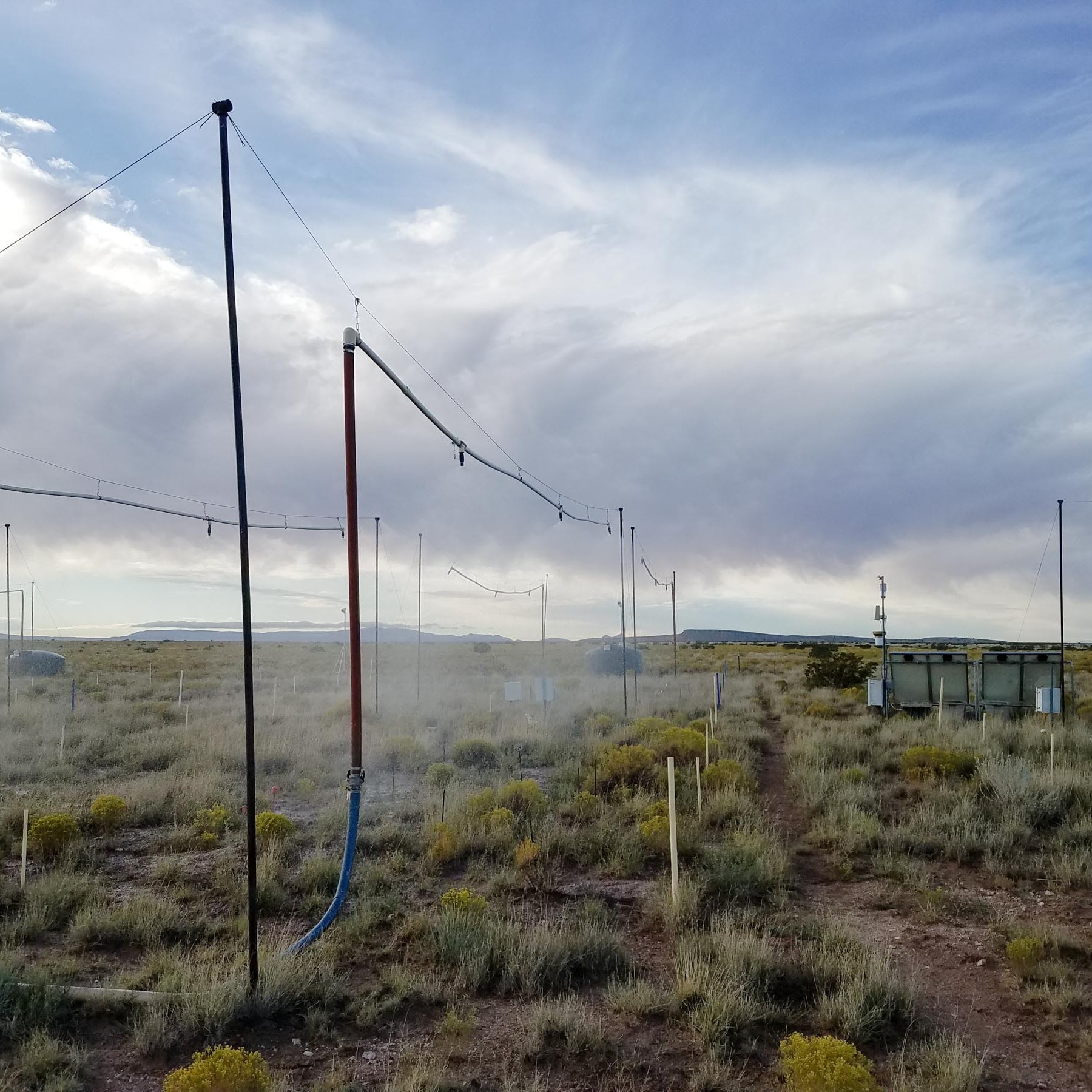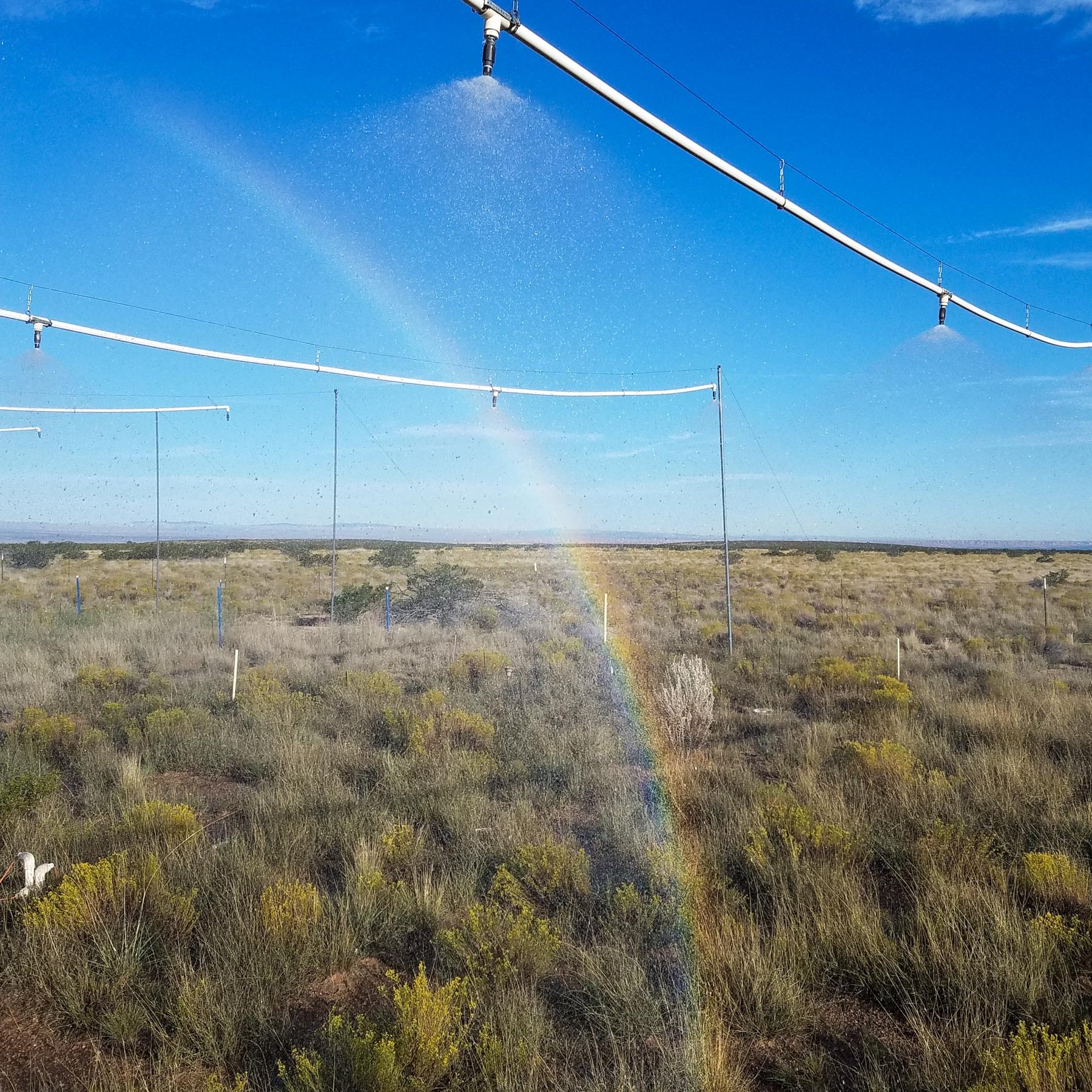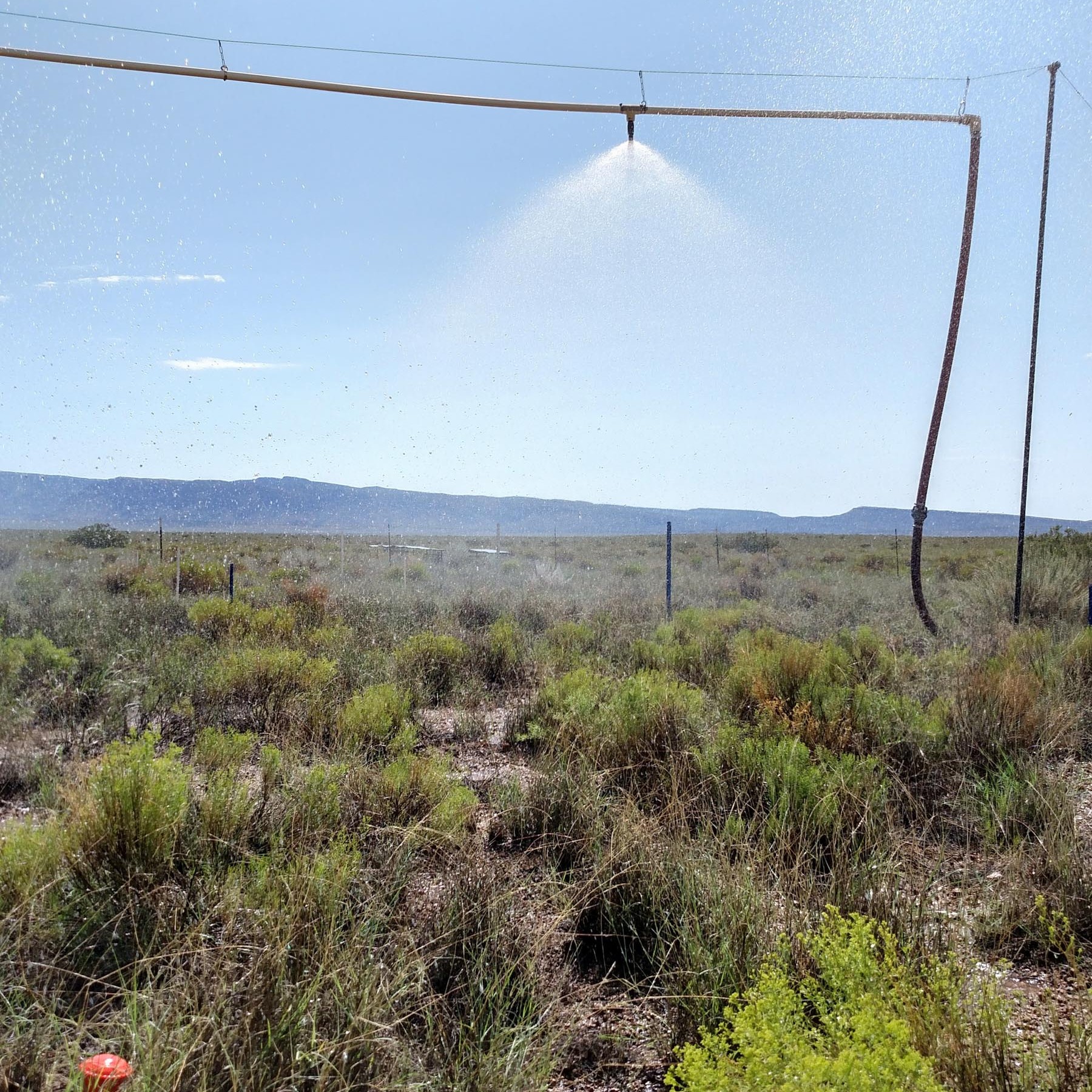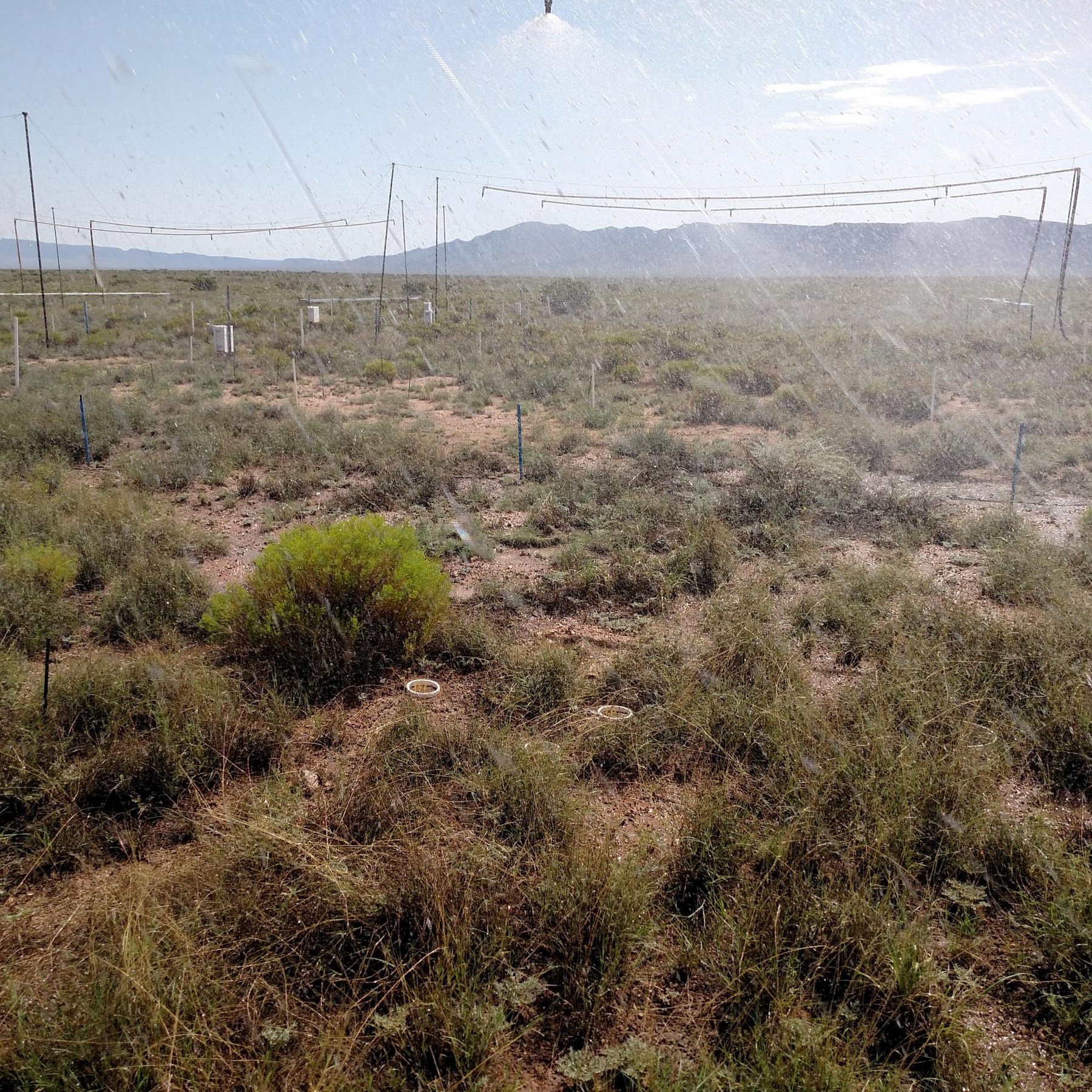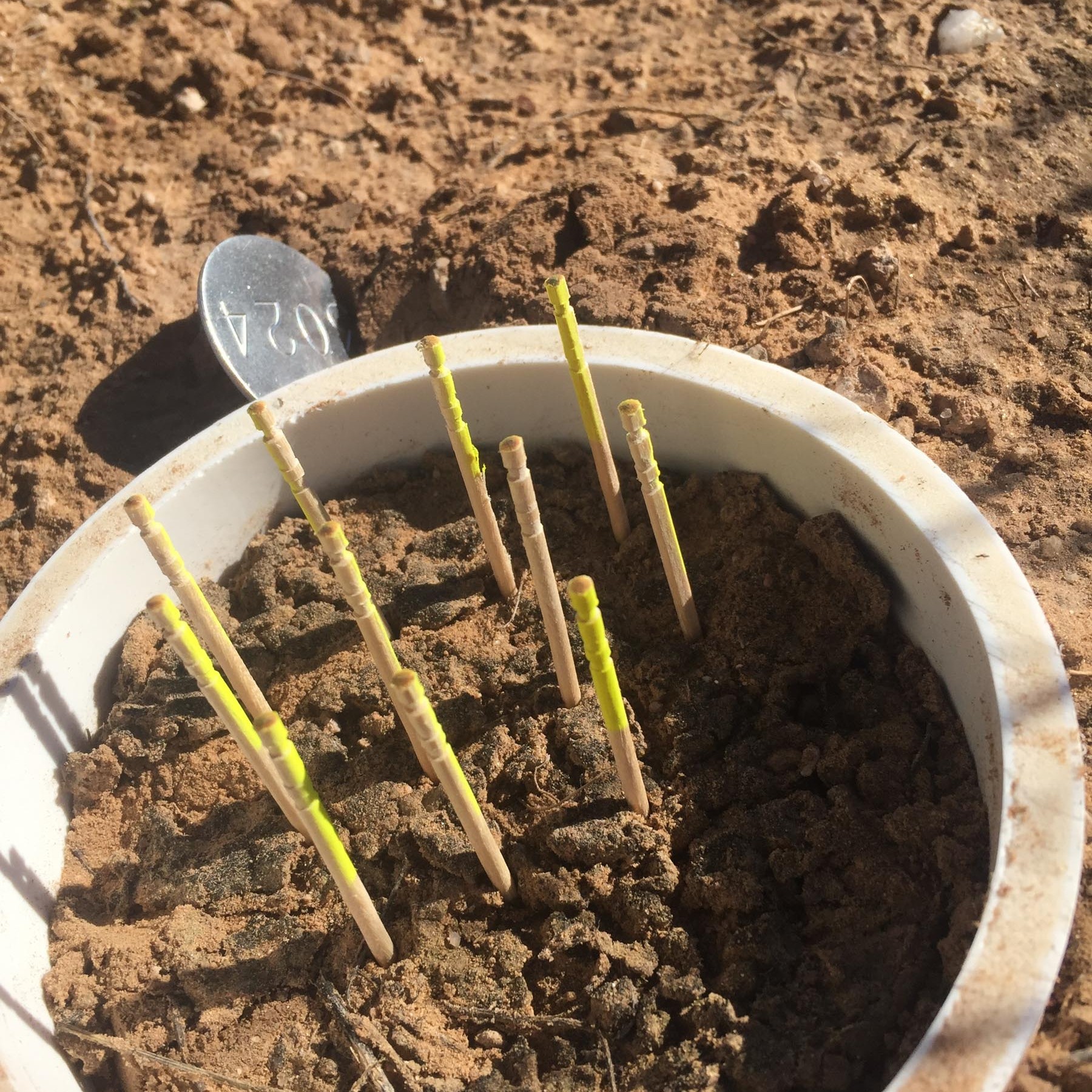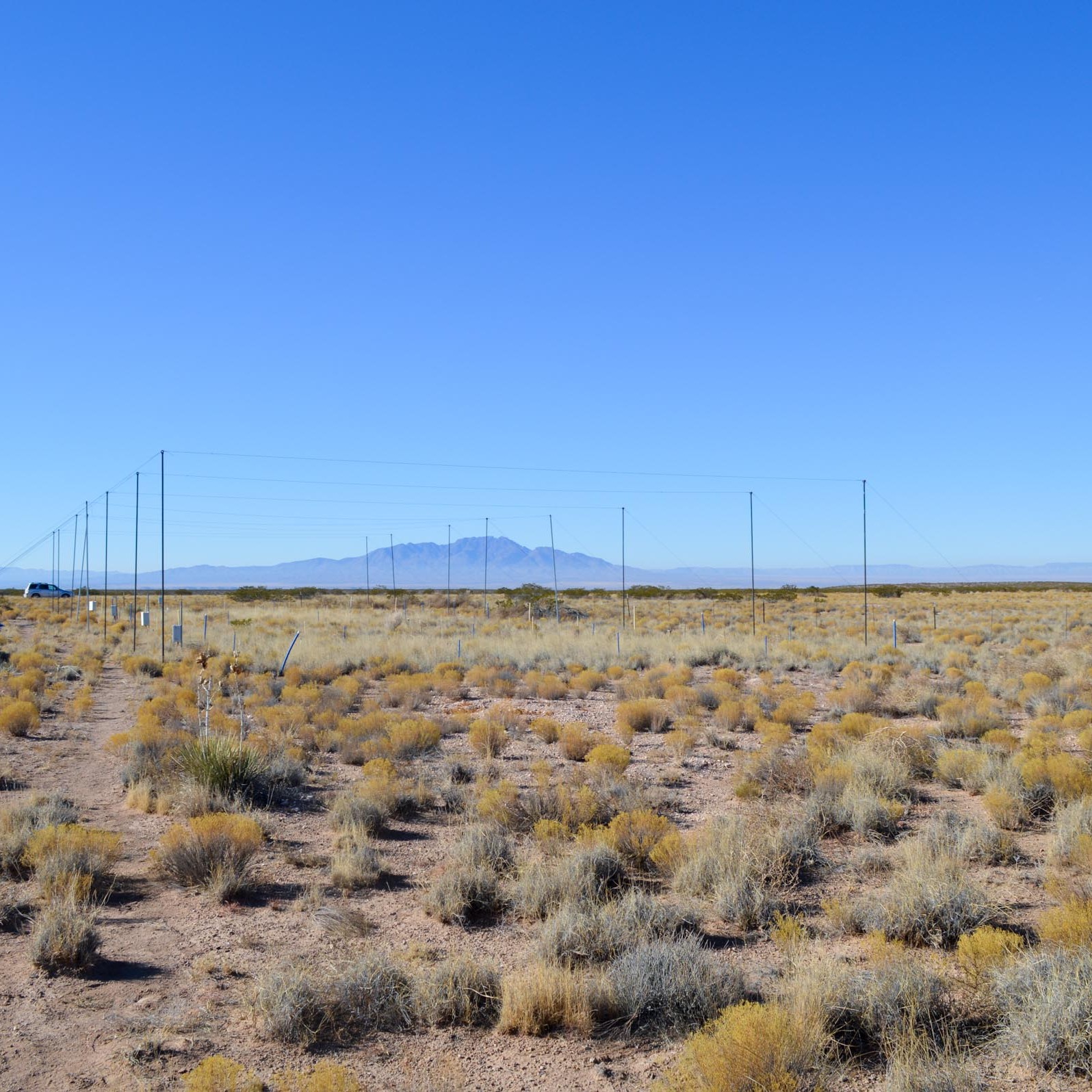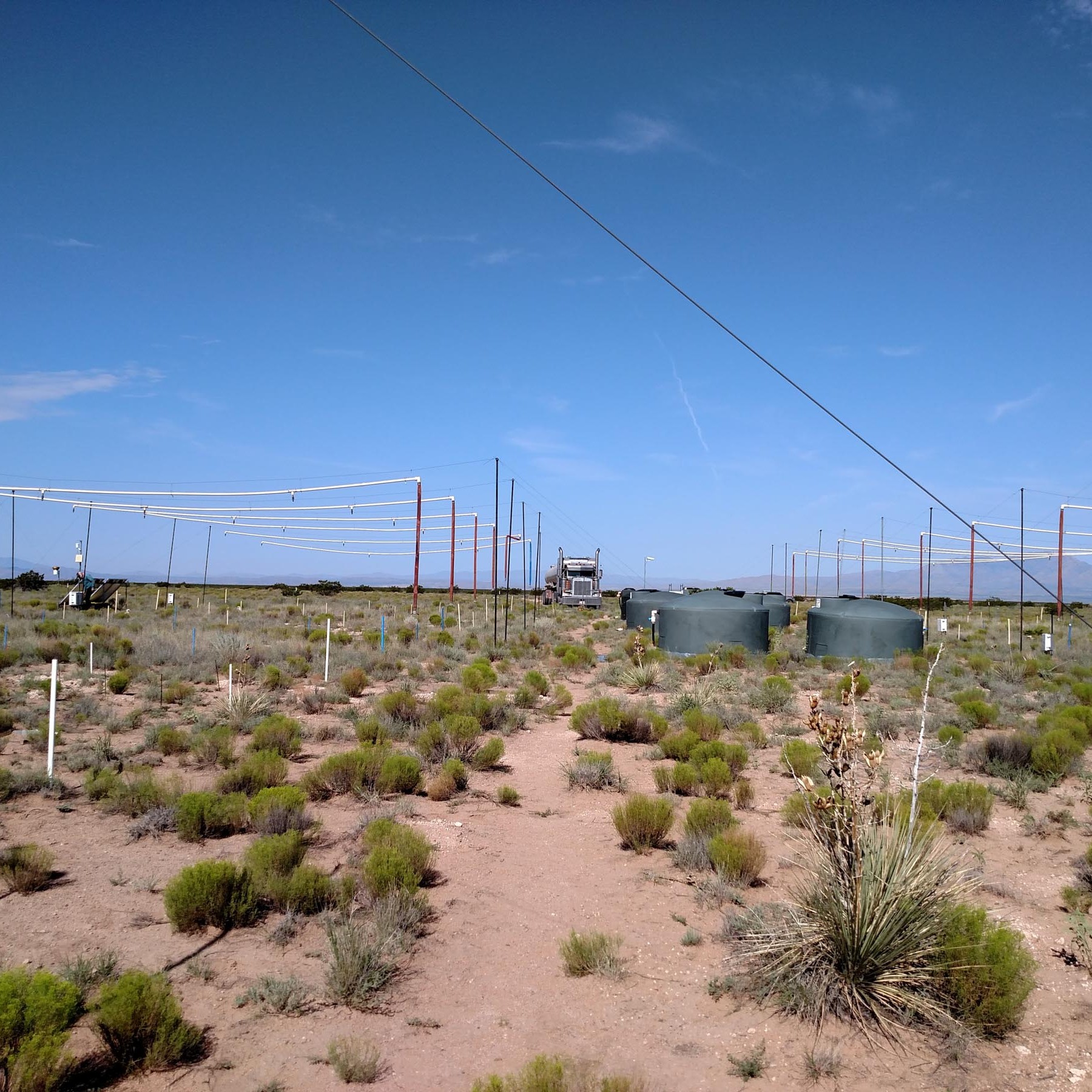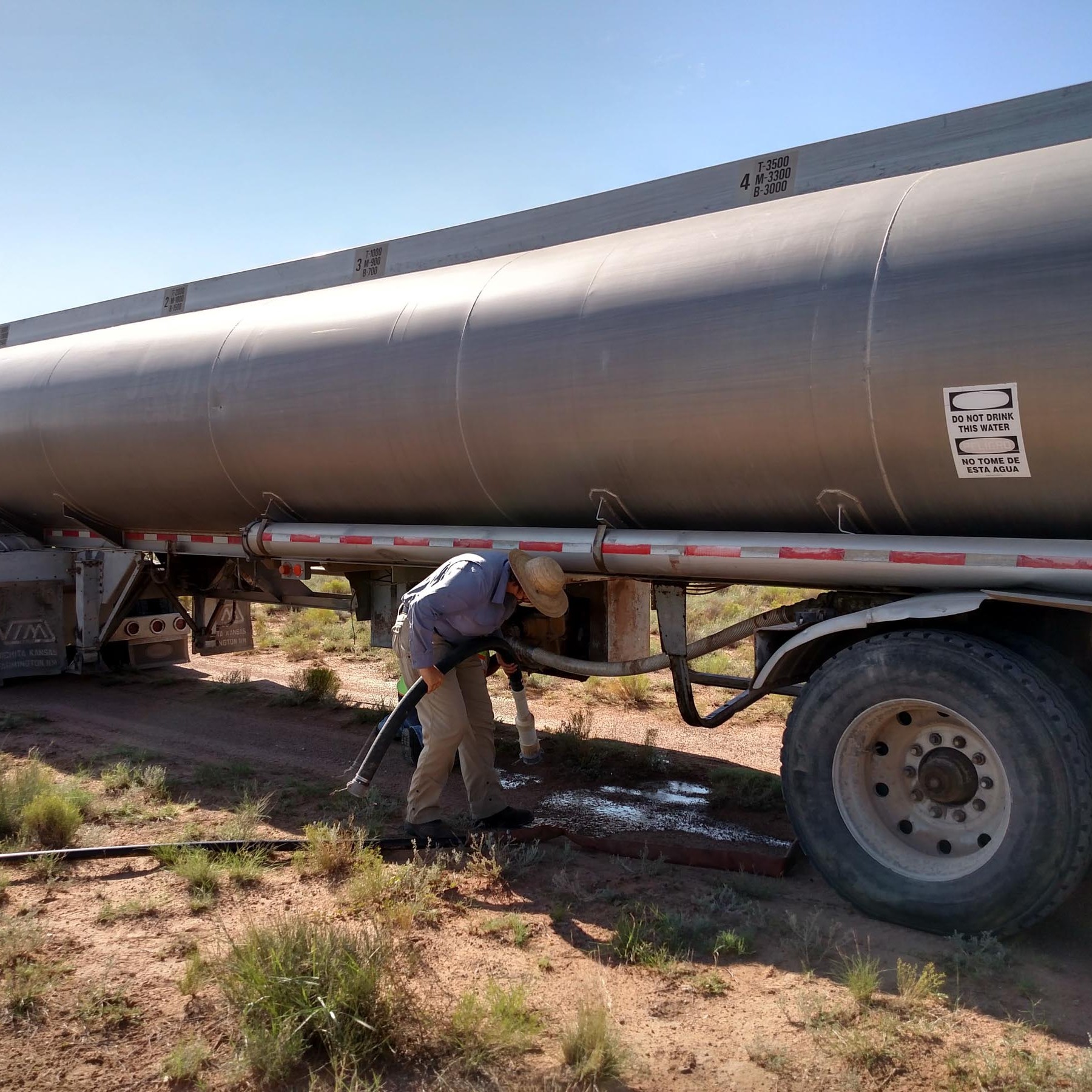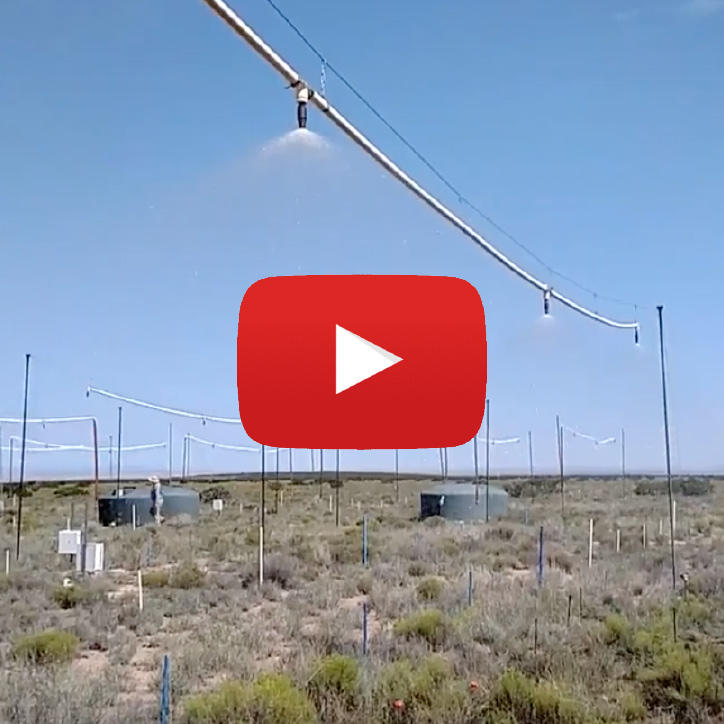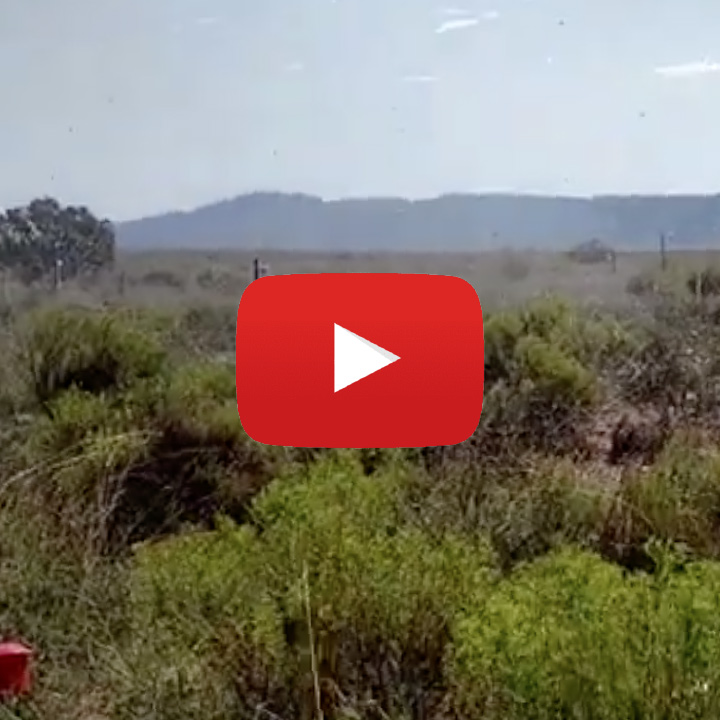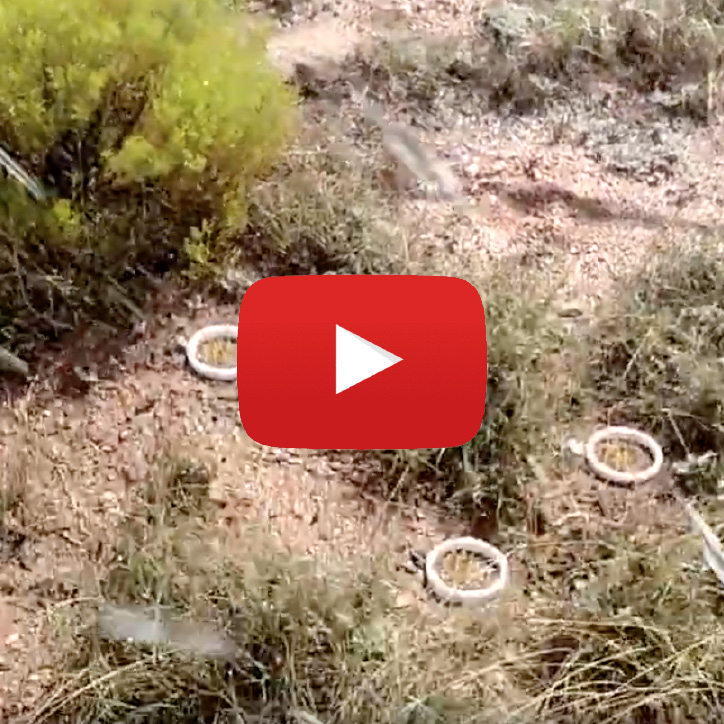Objective:
The monsoon rainfall manipulation experiment (MRME) addresses the impacts of increased precipitation variability on the potential for plant community reordering in Chihuahuan Desert grassland by shrub encroachment. The overarching question is, How does the size and frequency of rain events affect post-fire ecosystem processes and the potential for shrub encroachment into grassland? MRME started in 2006 with Univ of New Mexico start-up funds to Collins, and is now supported by NSF LTREB and LTER.
Like most regions, models predict an increase in precipitation variability under climate change in the southwestern US. Although total monsoon precipitation has not changed over the past 100 years at SEV, the number of rain events per day increased slightly while average event size decreased slightly. In addition, wet years have only 2-3 additional large rain events relative to dry years. Where adults of black grama grass (Bouteloua eriopoda) and creosotebush (Larrea tridentata) co-occur, the fibrous-rooted black grama appears to be a better competitor for soil moisture than the more deeply rooted, but drought tolerant creosotebush. During establishment creosotebush seedlings must compete directly with black grama for shallow soil moisture. Thus, if changes to rain event size and frequency alter soil moisture depth and infiltration, then an increased frequency of small rain events could potentially increase the resistance of grassland to shrub invasion.
Novelty:
In comparison to experiments that manipulate the climate average (e.g., hotter, drier), many fewer studies have investigated how variability in climate affects populations, communities, and ecosystems. In our region, within-season variability is on the rise: The long-term pattern in climate data shows more frequent but smaller events have increased over the past century (Petrie et al. 2014). Our experiment detects the ecological consequences of changes in the regime, or pattern, of rainfall, while holding the total amount of rainfall constant. Over the long-term, we can newly evaluate the potential for interactions between within-season precipitation variability and interannual precipitation variability because MRME treatments occur over a highly variable background climate.
Design:
We manipulate rainfall event size and frequency using a fully randomized design with a total of thirteen 8 m x 13 m plots. Control plots (n=3) receive ambient precipitation. Two rainfall treatments (n=5) are applied each year during the monsoon. The Few-Large treatment receives ambient rainfall plus one 20 mm rain event each month (i.e., increased rainfall event size). The Many-Small treatment receives ambient rainfall plus four 5 mm rain events each month (i.e., increased rainfall event frequency). Thus, we add the same amount of rain over the monsoon season (60 mm), but we vary the size and frequency of applied precipitation events, increasing variability without imposing unrealistically extreme rainfall amounts. The overall precipitation added per monsoon season is equivalent to an increase of ~40% over an average year (long-term monsoon mean ~150 mm). The 20 mm events simulate more extreme precipitation events, and the 5 mm events represent modal precipitation event size. On average, 70% of natural precipitation events are <5 mm and 12% are between 10 – 20 mm (1988–2008). On August 4, 2009, a lightning-initiated fire began on the Sevilleta National Wildlife Refuge near MRME. The experimental site was entirely burned on this date, with all plots subjected to high intensity wildfire.
Responses:
MRME replicates are instrumented with soil moisture, temperature, and CO2 probes (Campbell Scientific CS107 temperature probes, Campbell Scientific CS-616 moisture probes buried at a 45o angle to obtain an integrated measure of moisture in the top 20 cm, Vaisala CARBOCAP CO2 sensors (GMM222, Vaisala, Helsinki, Finland) placed at three depths (2, 8, and 16 cm)). Each replicate has two 2 m x 2 m subplots, one of which is fertilized with 5 g N m-2 y-1 as NH4NO3. Aboveground net primary production (NPP) and plant species composition are measured in two 1-m2 quadrats in each fertilized and control subplot twice yearly. Belowground NPP is measured with root in-growth donuts.
Supporting Documents:
Mega plant files pending on EDI
Monsoon Rainfall Manipulation Experiment (MRME) Soil Temperature, Moisture and Carbon Dioxide Data from the Sevilleta National Wildlife Refuge, New Mexico. https://portal.edirepository.org/nis/mapbrowse?scope=knb-lter-sev&identifier=304
Collins, S. 2020. Monsoon Rainfall Manipulation Experiment (MRME): Soil Nitrogen Data from the Sevilleta National Wildlife Refuge, New Mexico (2007 – 2020). https://portal.edirepository.org/nis/mapbrowse?scope=knb-lter-sev&identifier=309
Monsoon Rainfall Manipulation Experiment (MRME): Net Primary Production Quadrat Data at the Sevilleta National Wildlife Refuge, New Mexico. https://portal.edirepository.org/nis/mapbrowse?scope=knb-lter-sev&identifier=188
Collins, S. 2016. Monsoon Rainfall Manipulation Experiment (MRME) Meteorology Data from a Chihuahuan Desert Grassland at the Sevilleta National Wildlife Refuge, New Mexico (7/2007 – 8/2009). https://portal.edirepository.org/nis/mapbrowse?scope=knb-lter-sev&identifier=188
Monsoon Rainfall Manipulation Experiment (MRME): Seasonal Biomass and Seasonal and Annual NPP Data at the Sevilleta National Wildlife Refuge, New Mexico. https://portal.edirepository.org/nis/mapbrowse?scope=knb-lter-sev&identifier=206
Kwiecinski, J.V. 2019. Effects of Altered Precipitation on Biological Soil Crusts, Fungi, and Soil Nitrogen Availability at the Monsoon Rainfall Manipulation Experiment (MRME) in the Sevilleta National Wildlife Refuge, New Mexico (2016). https://portal.edirepository.org/nis/mapbrowse?scope=knb-lter-sev&identifier=320
Related Publications:
Herrera, J., R. Poudel, K.A. Nebel and S.L. Collins. 2011. Precipitation increases the abundance of some groups of root-associated fungal endophytes in a semi-arid grassland. Ecosphere 2: https://doi.org/10.1890/ES11-00001.1
Thomey, M.L., S.L. Collins, R. Vargas, J.E. Johnson, R.F. Brown, D.O. Natvig, and M.T. Friggens. 2011. Effect of precipitation variability on net primary production and soil respiration in a Chihuahuan Desert grassland. Global Change Biology 17: 1505-1515. https://doi.org/10.1007/s00442-014-3052-1
Thomey, M. L., S. L. Collins, M. T. Friggens, R. F. Brown, and W. T. Pockman. 2014. Effects of monsoon precipitation variability on the physiological response of two dominant C-4 grasses across a semiarid ecotone. Oecologia 176:751–762. https://doi.org/10.1007/s00442-014-3052-1
Vargas, R., S.L. Collins, M.L. Thomey, J.E. Johnson, R.F. Brown, D.O. Natvig, and M.T. Friggens. 2012. Precipitation variability and fire influence the temporal dynamics of soil CO2 efflux in an arid grassland. Global Change Biology 18: 1401-1411. https://doi.org/10.1111/j.1365-2486.2011.02628.x
Kwiecinski, J. V., E. Stricker, R. L. Sinsabaugh, and S. L. Collins. 2020. Rainfall pulses increased short-term biocrust chlorophyll but not fungal abundance or N availability in a long-term dryland rainfall manipulation experiment. Soil Biology and Biochemistry 142:107693. https://doi.org/10.1016/j.soilbio.2019.107693
Petrie, M. D., S. L. Collins, D. S. Gutzler, and D. M. Moore. 2014. Regional trends and local variability in monsoon precipitation in the northern Chihuahuan Desert, USA. Journal of Arid Environments 103:63–70. https://doi.org/10.1016/j.jaridenv.2014.01.005

